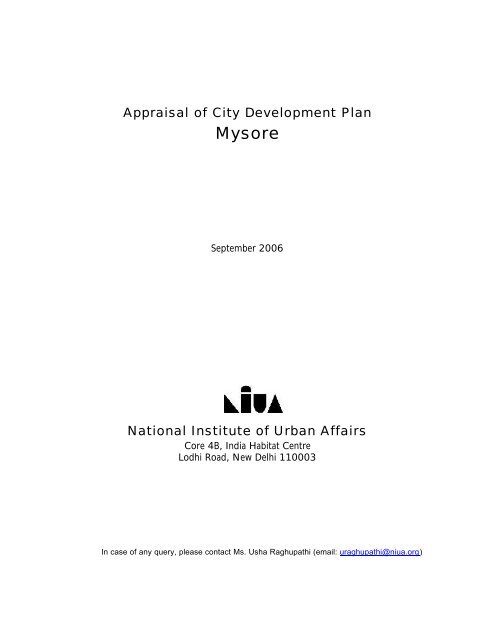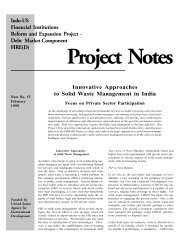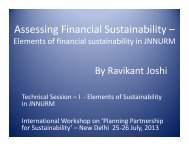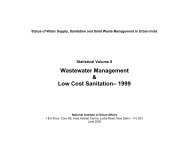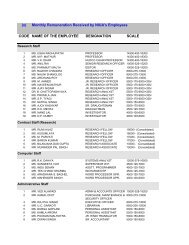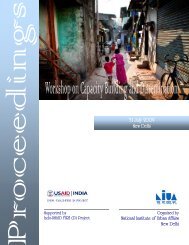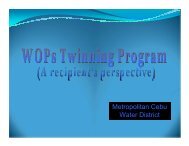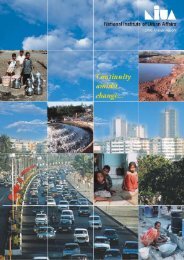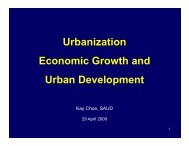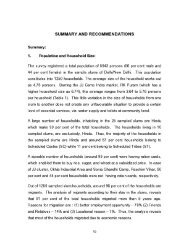Mysore - JnNURM
Mysore - JnNURM
Mysore - JnNURM
You also want an ePaper? Increase the reach of your titles
YUMPU automatically turns print PDFs into web optimized ePapers that Google loves.
Appraisal of City Development Plan<strong>Mysore</strong>September 2006National Institute of Urban AffairsCore 4B, India Habitat CentreLodhi Road, New Delhi 110003In case of any query, please contact Ms. Usha Raghupathi (email: uraghupathi@niua.org)
Appraisal of City Development Plan of <strong>Mysore</strong>The City Development Plan (CDP) of <strong>Mysore</strong> has been appraised using the guidelines given inToolkit 2.The first part of the CDP of <strong>Mysore</strong> contains the background of the regions, the existing situationanalysis, the vision, the implementation of the vision and the financial sustainability analysis.The CDP has not fully followed Tookit 2 and does not give much importance to the existingsituation analysis. It concentrates more on the vision, the projects and the financial plan, whichshould be based on the existing situation. The CDP has not been structured well and isfragmented.Chapter 1 of the CDP, which deals with the background of the <strong>Mysore</strong> Urban Region, gives areasonably clear overview of the importance and the main attractions of the city. It also gives avery brief description of the economy, transport, educational and research institutions in the cityand spiritual tourism.<strong>Mysore</strong> is an educational, commercial and administrative centre and also an important tourist andheritage centre. The economy of the city is largely centred on tourism, industry and commerce.The section on Governance in this chapter (p. 15-21) gives the institutional responsibility of eachagency that plays a role in the governance of the city. It discusses the role of the <strong>Mysore</strong> CityCorporation (MCC), the <strong>Mysore</strong> Urban Development Authority (MUDA), the Karnataka UrbanWater Supply and Drainage Board (KUWSDB), the Karnataka State Road Transport Corporation(KSRTC), the Public Works Department, the Zoo Authority, the Department of Archaeology andthe Lake Development Authority. While discussing the functions of MCC, this section does notclearly indicate which of the functions listed in the Twelfth Schedule of the 74 th ConstitutionAmendment have been transferred to MCC.Existing Situation AnalysisChapter 2 on Analysis of Existing Urban Situation gives an extremely brief overview, like anexecutive summary, of the existing situation. There is hardly any analysis done of the presentsituation. From this section one does not get a clear idea of what is available in the city, what islacking, where the deficits are and what are the reasons for the deficits.Demography“Demography” on p. 23 gives the population from 1901 to 2011 with growth rates. Themethodology used for population projection has not been stated in the CDP. There are no figuresgiven for population increase due to natural causes, migration and jurisdictional changes. Thereis no analysis of population growth of the city and the surrounding areas. This needs to be given.The graph on population forecast needs to be redone as the titles on X and Y axis are blacked out.Land-useThe CDP provides no analysis of land use pattern of <strong>Mysore</strong> and surrounding areas. Three mapson land-use have been given on p. 23 and 24 for the years 1972, 2001 and 2011. The maps makeno sense as nothing is visible in these maps. These maps which were originally in colour and
were very big, have been reduced to very small size, so the maps have become meaningless.While the land-use maps are given on p. 23 & 24, the table on land-use is given on p.38. Thetable and text should go together. A full discussion on land-use should be given with analysis andwith visible maps for the city and the surrounding areas.Urban poorOnly one paragraph on urban poor is given in chapter 2, p. 24, which hardly gives an idea of theurban poor in the city. Some more coverage of urban poor is available in Chapter 4 on BasicServices to Urban Poor (p. 54 to 60). However, even this chapter does not give a comprehensivepicture of the urban poor and their living conditions at present.There is confusion in the number of slums in the state and the city. In column two of p. 54, it isstated “Out of total 1957 slums declared in the State, 219 declared slums are in Bangalorecity…..”. In the paragraph just below this it is stated, “There are over 4000 slums in the State.Of them, over 1000 slums are in Bangalore while there are 82 slums in <strong>Mysore</strong> where 49 slumsexist in the city corporation limits”. In Annexure 7, p. 62, the table gives the number of declaredslums in <strong>Mysore</strong> city as 20 and the undeclared slums as 17. It needs to be clarified as to howmany declared and undeclared slums are there in the state of Karnataka, in Bangalore and in<strong>Mysore</strong>.On p. 57 it is stated that 36,100 houses are required for the urban poor in the city. This is basedon the assumption that the BPL population would be 19% of the total population. However, thebasis for arriving at this percentage of BPL population is not given. The population of the urbanpoor in the city, the trends and the projections need to be given and analysed in this section.The discussion on urban poor in the CDP is more theoretical indicating what should be done butdoes not give hard facts and figures. This section should give quantitative and qualitativeinformation on the situation as it is found in the city at present.Service levelsThe information on service levels is fragmented. The section on Service Indicators (p. 25) doesnot give service delivery levels – it gives only weightages and scores. Some information onservice levels is available on p. 48 in Chapter 3 on Vision. The information on cost recovery inurban infrastructure is given on p. 37. The CDP does not give consolidated information onservice levels and their finances in one place and this makes it difficult to understand the presentstatus of these services.The discussion of water supply, sewerage and storm water drainage, on p. 26 & 27, does not givemuch idea of these services in the city. On p. 67 & 68 of the CDP, in the chapter onImplementing the Vision (Chapter 5), the activities for improving water and sewerage servicesare given. The items given on p. 67 & 68 should be first discussed in detail in the section onexisting situation, only then the improvement envisaged can be understood.It is not clear, from p. 28, why the disposal of wastewater is only 15.25 mld when the wastewatergenerated is 128 mld and 57% of the households are connected to the sewerage system. Whilethe capacity of the STPs adds up to 157.65 mld, the present operating capacity is mentioned as15.8 mld only. The percentage of households connected to the sewerage system needsclarification as the table (on p. 28) indicates 57% and the text directly below the table indicates2
70% coverage. The coverage of households by sewerage system and the wastewater generated donot match. This needs to be clarified.Similarly, the very brief write up on solid waste management, on p.27, does not give any idea ofhow the service is being managed at present. A detailed discussion needs to be provided on theitems indicated on p. 70, which includes collection, transportation, treatment and disposal.Roads and bridges are briefly discussed on p. 28 & 29, but there is no discussion on transport.Projects have been proposed for transport on p. 64, 65 & 66 without any discussion of theexisting situation.Institutional ResponsibilityThe institutional responsibility matrix (p. 26) indicates the institutions responsible for variousservices and functions. However, there is no discussion on the overlapping functions of agencies,if any, and the problems in management due to these. The discussion on Governance, p. 15-21,could have been brought under this section.Finances of MCCThe financial profile of MCC is given in tables on p. 36 & 37 with no analysis. Comments on thefinances of MCC are provided in Chapter 6 on pages 78 to 84.Revenue and Expenditure of MCC(Rs. lakhs)Year Revenue ExpenditureSurplus/deficit2001-02 7748.95 7845.06 -96.112002-03 7132.96 7355.97 -223.012003-04 6984.25 7048.17 -63.922004-05 7537.30 8110.26 -572.962005-06 9036.00 9076.66 -40.66The CDP indicates that the financial position of MCC has not been very robust in the past and theCorporation’s budget has been running in deficit.Figures obtained from the Budget Estimates of <strong>Mysore</strong> Mahanagar Palike indicate that all thefigures of revenue and expenditure used in the CDP are estimates and not actuals. Since theactuals would be available uptil 2004-05, these figures should be used and the entire set of tableson MCC’s finances redone and the analysis re-written accordingly.As per the figures available in the CDP (for 2003-2006) property tax formed about 17-19 % ofthe total revenue of MCC, followed by other property based receipts (18-20%) and water charges(15-16%). Funds from the State Finance Commission formed about 21-24% per cent of the totalrevenue while grants and contributions formed 18-22%. Revenue receipts from all the sourceshave shown fluctuation in the last five years, but the reasons for this has not been given. As perthe CDP, the share of grants in the total revenue has been decreasing over the years while thecollection from property tax has been rising.3
“Repair and maintenance” accounts for about 16-17% of the total expenditure. However, about70-80% of the expenditure on this head is electricity charges and city cleaning expenses. Theexpenditure on this head has increased mainly due to an increase in electricity charges.Stakeholder ConsultationsChapter 3 of the CDP indicates that stakeholder consultations were held from December 2005 toApril 2006. Annexure 2, p. 4, gives the list of stakeholders. However, this list needs correctionas it gives both the list of stakeholders and also some action areas. Annexure 3, p. 6-13, gives the“stakeholders key responses”, but the responses are not easy to comprehend. There is noconsolidated list of responses available in the CDP. This needs to be given. The discussion onstakeholder consultations should give the number of meetings held, the number of peopleattending these meetings and the consolidated list of responses it generated. It should alsoindicate if all sections of society were covered and what were the priorities of people with respectto services and infrastructure.Vision for the City“Enhancing the glory of <strong>Mysore</strong>, and enabling it to forge ahead as the cultural, tourism,educational, and wellness hub” is the vision of <strong>Mysore</strong>. The key elements of vision (p. 41) aregiven as urban space, economy, heritage, and governance.The CDP indicates that the city would specifically focus on tourism, which would include a focuson heritage and monuments, and palaces in <strong>Mysore</strong>, handicrafts/ sericulture, and informationtechnology/ biotechnology. The specific service and infrastructure targets to be achieved in theshort-term, medium-term and long-term are given on p. 48 & 49. These include targets for waterand sanitation, urban roads, solid waste management, and basic services to the urban poor. Theyears to which short, medium and long term refer to is not given in the tables on p. 48& 49. Thisshould be given.PrioritiesInfrastructure priorities are given in a table on p. 53. Since specific priorities are not mentioned,it is assumed that roads, road related infrastructure, water supply and sewerage, municipal solidwaste management, urban poor and tourism are the priority areas, in that order. The columns inthis table need further explanation as to what it is trying to depict.StrategiesThe strategies for achieving the vision are given in Chapter 5 – Implementing the Vision (TheCIP). The investments proposed in this chapter give the capital expenditure, O&M, and landacquisition cost, wherever applicable. Due emphasis has been laid on O&M while formulatingthe projects. However, there is no mention in the CDP of how the O&M costs will be met. Theproject cost indicated for funding under JNNURM excludes the O&M and land acquisition cost.The projects proposed are for the time periods 2007-12, 2013-17, 2018-22, 2023-27 and 2028-31,however, JNNURM funding is being sought only for the 2007-12 period.The project cost, though excludes O&M/ land acquisition cost, in some cases these have beenincluded. Therefore, the project cost has been recalculated to include only the capital expenditureand this has made a difference of Rs. 409 crores. The project theme wise cost is presented below.4
(Investment in Rs. Crore)2007-12Project Themes As given in CDP Recalculated duringappraisalRoads 311 311Transport related infrastructure 428 378.5*Water and Sewerage 529 418Solid Waste Management 34 10Urban Poor 194 169Tourism 307 113**Urban Spaces 31 25.5Grand Total 1834 1425Note: The following ineligible components have been deducted from the totals:* excludes airport upgradation project for Rs. 90 cr.** excludes projects for Convention centre and Golf course for Rs. 150 cr. , and Budgethotel for Rs. 20 cr.Road and Transport projects<strong>Mysore</strong> is examining the feasibility of providing mass transport systems such as Bus RapidTransit, Electric Trolley Buses or Light Rail System (p. 65). This is one of the priorities forimproving the transport facilities in the city. MCC/ MUDA have identified corridors for roadimprovement along with related infrastructure; providing for comfortable pedestrian movement isone of the considerations. Development of pedestrian/ cycling zones is one of the projectsproposed for funding (for Rs. 2 cr.).Planning of roads should consider safety concerns of cyclists and pedestrians, and projects forthis should be developed through wide ranging consultations with concerned stakeholders. Thishas to be ensured and evidence provided of such consultations in the CDP.<strong>Mysore</strong> has a small airport, called Mandkalli Airport, approx. 4 miles from the city. The airport iscurrently inoperative. There is a plan to redesign and extend the airport for making it operationalfor small aircraft. Therefore, an airport upgradation project for Rs. 90 cr. has been proposed inthe CDP. However, this is an ineligible component and hence cannot be considered for fundingunder JNNURM.Tourism related projectsUnder this head, the infrastructure around the existing attractions will be upgraded. The city hasalready prepared a list of all the heritage buildings/ monuments/ attractions and the respectiveagencies are expected to prepare the rehabilitation/ conservation plans. A project has beenproposed for the Renovation of Heritage Buildings for Rs. 50 crores. The CDP, in Annexure 2, p.106, gives a list of Heritage and other important buildings in <strong>Mysore</strong>, consisting of 32 buildings.However, pages 107 to 112 give a list of 138 buildings. It is not clear what these two lists are.Two tourism related projects are ineligible for funding under JNNURM. These are ‘ConventionCentre and Golf Course’ for Rs. 150 crores and a ‘Budget Hotel’ for Rs. 20 crores.5
Financial SustainabilityThe <strong>Mysore</strong> City Corporation has been showing a deficit on its revenue account for the past fiveyears i.e., from 2001-02 to 2005-06 (p. 80). However, the financial operating plan for 2006-07shows a surplus of Rs. 317 crores and a surplus of Rs. 2226 crores for 2007-08. This does notseem very realistic. One of the assumptions on which these projections are based states that theproperty tax rates would be revised upward by 20% every 5 years and the collection efficiencywould go up to 60% in the first year and 70% in the second year. However, the CDP is silent onthe present collection efficiency and when the property tax rate was last revised. Similarly, theother assumptions given on p. 81 are not backed by an analysis of the present situation, whichwould have given an idea of how realistic these assumptions are. Therefore, the statement on p.84, “…the MCC could meet up to Rs. 106 crores out of the budgetary surplus…” does not seemvery accurate. The above points need to be explained.Overall, the CDP does not fulfil all the requirements of Toolkit 2. Based on the comments givenabove, the CDP will have to be redrafted. The city may also have a look at the structure of CDPsof Gujarat (Ahmedabad, Surat, Vadodar and Rajkot) and the CDPs of Andhra Pradesh(Hyderabad, Vishakhapatnam and Vijayawada), available on the Internet, for assistance.<strong>Mysore</strong> is a Heritage City and the Ministry of Urban Development has prepared separateguidelines for the preparation of CDPs of these cities. The guidelines are attached as Annex 1 forready reference. While the present CDP has covered some of the information required forHeritage cities, a lot of additional information is still required to be given. These may be done inorder to comply with the requirements of CDP for Heritage cities.6
Additional Points raised on <strong>Mysore</strong> CDP1. Since most of the sections indicate the goals and visions for the mission period and for alater period, the same can be given for water supply also, which is not given at present.2. In the Annexures, pages 2 & 3 give the name of 22 stakeholders consulted and page 6 &7 give the name of another 25 stakeholders. This makes a total of 47 stakeholdersconsulted. Is that all? If more stakeholders have been consulted, then please give thetotal number of participants in each of the meetings held. Also two pages of photographswould be more than enough, details of the stakeholders and what emerged is moreimportant than the photographs.3. Can inter-sectoral prioritisation be spelt out more clearly on p. 81?4. None of the tables have a title or number. This makes it difficult to refer to the table. Sothe following comments are written in a strange way. The tables should be numberedwith titles.5. On p. 48, the table's third row states 'not fully covered' against the item on metering -what is meant by this? What % of households are covered by metering? On p. 53 thetable on sewerage states that 57% households are connected to the sewerage system. Sothis type of figure should be available for water supply too.6. On p. 49 (water supply section), the second table's third row's third column gives a figureof 4 - what is the unit of this figure?7. On p. 77, it is stated that the income from water supply and sewerage services hasincreased by 105% between the FY 2002 and 2005, but there is no explanation given forthis increase. The table also indicates that the Expenditure has fallen since FY 2002 - thisneeds to be explained. The table further shows that the income from water supply wasthree times the expenditure in FY 2002 and has gone up to almost seven times in FY2005 - this too needs to be explained. How is <strong>Mysore</strong> making so much surplus on watersupply and sewerage head. A break-up of the figures by heads needs to be given. Itwould also be useful to give the tariff for these services.8. Since the CDP gives a table for Municipal Capital Receipts, a table for Municipal CapitalExpenditure may also be given.9. On p. 78, the second table does not indicate the year to which the figures belong. Thistable needs to be given for the FY 2001 to 2005.7
10. Since most of the sections indicate the goals and visions for the mission period and for alater period, the same can be given for water supply also, which is not given at present.11. In the Annexures, pages 2 & 3 give the name of 22 stakeholders consulted and page 6 &7 give the name of another 25 stakeholders. This makes a total of 47 stakeholdersconsulted. Is that all? If more stakeholders have been consulted, then please give thetotal number of participants in each of the meetings held. Also two pages of photographswould be more than enough, details of the stakeholders and what emerged is moreimportant than the photographs.12. Can inter-sectoral prioritisation be spelt out more clearly on p. 81?These are the concerns based on our earlier comments. Please address these concerns also in therevised CDP.8


